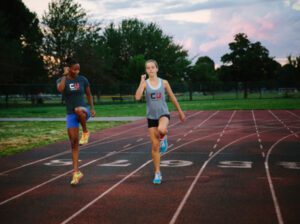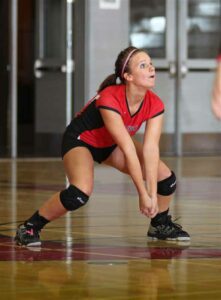The first question I always ask a family when discussing the possibilities of an athlete pursuing an athletic scholarship is “whose dream is this?” This is key. Mom and Dad aren’t going to be the ones getting up at 5:00 AM to get to the early conditioning workouts, it has to be the athlete’s goal to play in college – it is a huge commitment. After we get the answer to that question we move forward to formulate the plan.
After 13 years of college coaching and spending the last four years traveling to AAU tournaments, talking to parents, researching the recruiting nuances of the various sports and helping athletes – I have come to a conclusion.
-Knowledge and Preparation are the keys to success in the recruiting process-
Each student athlete and their parents should have reasonable knowledge of the recruiting rules, recruiting calendars, how coaches recruit – and – a clear understanding of your athlete’s short and long-term goals. These things are critical in getting exposure to the right schools for you. The recruiting rules are mandated by the NCAA (National Collegiate Athletic Association). There are rules that apply to every prospective student-athlete (PSA) and there are sport specific rules. These rules set the tone for college recruiting even though not every university in the country falls under these guidelines. There is another governing body called the NAIA (National Association of Intercollegiate Athletics). I’ll be covering these two entities in more detail as a topic for future articles, so stay tuned.
Registering with the NCAA Eligibility Center:
Every athlete that wants to be recruited by an NCAA Division I and Division II Institution must register with the NCAA Eligibility Center their junior year in high school. The EC determines an athlete’s Eligibility to compete and their Amateur status. An athlete must be cleared through the EC before he or she can take an Official visit to an NCAA Institution.
• An official visit is a 48-hour expense paid visit to a collegiate institution. Each athlete is limited to five and only one per institution.
• Each sport has a recruiting calendar, which defines when coaches can begin the recruiting process with PSAs. This pertains to contacts, evaluations, phone calls and general correspondence.
• Visit www.ncaa.org to obtain a copy of the “NCAA Guide to the College-Bound Student-Athlete” for specifics.
Recruiting is a Game, Know the Rules:
It is important to understand how and when coaches recruit in order to position yourself properly in the recruiting process. You have all heard the expression “Players aren’t born, they are made in the off-season.” As former Notre Dame football coach Lou Holtz says, “Ability is what you’re capable of doing. Motivation determines what you do. Attitude determines how well you do it.” We tend to think that what we do during the season makes or breaks our chances of being recruited. Think again. Coaches don’t recruit during the season; they recruit in the off-season and the summer. With budgets being cut and time being limited they will spend a good deal of time finding out about players before traveling to see them play. They do this through high school coaches, travel team coaches, self-solicitation of athletes, and scouting services. Each sport has a few reputable services they probably subscribe to. These services go out and watch players, write an evaluation and compile a list for coaches. Many of the opportunities they may have for assessing talent is coming in the off-season during showcases and club sporting competition.
This is all good stuff, but it is really important to get video to coaches. Stats aren’t always relevant, as they may not give a true picture of the level of competition. Getting video to coaches is critical. Each sport has its own form of content that the coach is looking for. Video that reviews specific skill sets, overall assessments of speed, conditioning, jumping ability in the context of that sport… in addition to game film, can really make a difference and help a lot – for coaches “seeing is believing”.
The most frequent question I get from parents and athletes is “when do I get started”? I tell them if you are playing on the varsity team your freshman year then it is not too early. Only varsity experience is relevant. Coaches do not want JV material. You don’t want to wait until your senior year. The most critical for most sports is your junior year and summer before your senior year. Football is one of the few sports that waits to see how your senior season goes to make a final decision. Men’s and Women’s Basketball will generally start looking seriously at players the summer before the junior year as they may start to offer scholarships to juniors.
Put together a “Portfolio” and send it to college coaches before going to an exposure event or doing an unofficial visit on a college campus. Understand that coaches go to exposure events (showcases) to view as many athletes as they can. They also set their viewing schedule around athletes that they already know about. They may have seen video, which has peaked their interest and now want to see that athlete play live. Remember, even though a coach has come to observe another athlete – if your performance is outstanding at these exposure events – you will attract attention.
Be Proactive
The best advice I can give to you is to BE PROACTIVE in the recruiting process. Don’t wait to see which coaches may be interested in you. Start researching schools, programs, and levels of play (Division I, II, III, NAIA etc.) If you have already had some college interest from schools that have seen you then you are likely a college prospect. Now, target the schools that you would be interested in attending and invite the coaches from those programs to come see you play.
Plan Ahead
When you are traveling to tournaments over the summer, find a couple schools along the way that might interest you and take a tour. Do an unofficial visit at the campus. Call the coach ahead of time to arrange a campus tour. Send them your portfolio with video ahead of time to introduce yourself. If they like what they see they will make more time for you if they can.
And finally, understand what level of competition will be best for you. Everyone wants to play in the “big time”, but only .8% of athletes get Division I scholarships. There are many tremendous opportunities out there. Ask your high school coach, your select team coach, an expert in your sport about what level may be best for you. Don’t waste your time chasing the wrong level. You could miss out on a great opportunity at the right level. Find the right fit academically and athletically and the financial piece will fall into place.
How useful was this post?
Click on a star to rate it!
Average rating 4 / 5. Vote count: 2
No votes so far! Be the first to rate this post.



